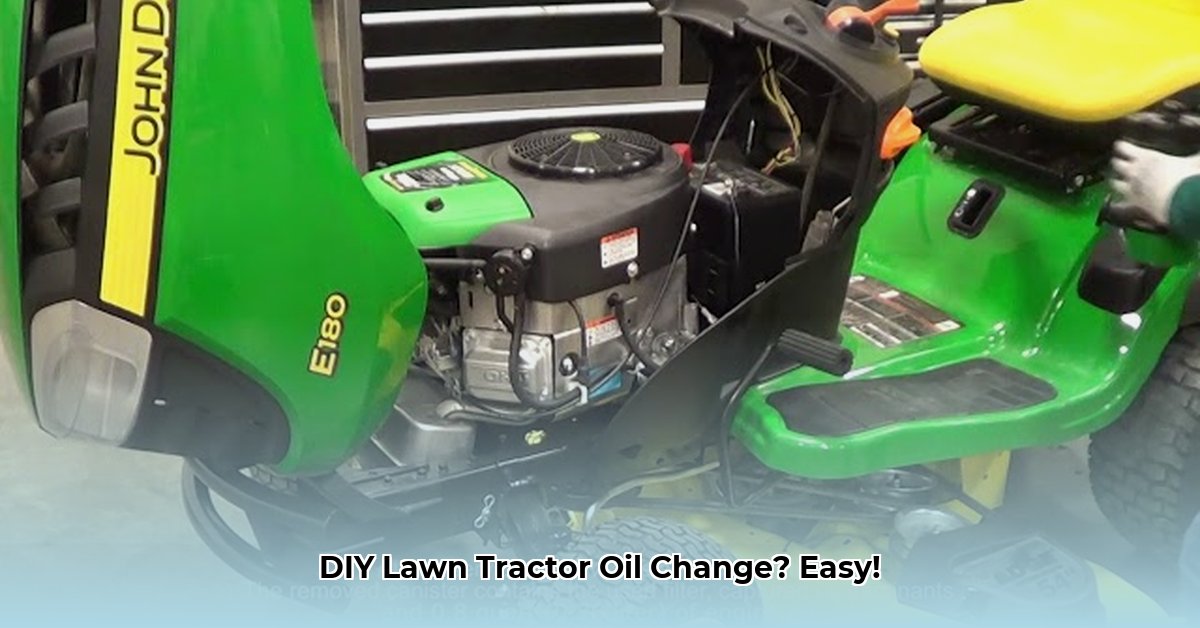
Getting Started: A Smooth Oil Change Journey
Regular oil changes are vital for your John Deere lawn tractor's longevity and performance. This step-by-step guide makes the process simple and straightforward, even for beginners. Don't worry – you've got this! Before we begin, let's address the frequently asked question: Why is changing your oil so important? Simply put, fresh oil lubricates your engine's moving parts, preventing wear and tear and extending its lifespan. Neglecting this crucial maintenance step significantly increases the risk of costly repairs down the line. For more detailed John Deere maintenance guides, see this helpful resource.
Gather Your Supplies: Prepping for Success
Think of this oil change as a mini-project. Having the right tools readily available streamlines the process:
- Fresh Oil: The type and quantity depend entirely on your John Deere model. Always consult your owner's manual for precise specifications. Using the wrong oil can damage your engine.
- New Oil Filter: This crucial component traps contaminants that could harm your engine. Again, check your owner's manual for the correct part number.
- Oil Filter Wrench: This tool makes removing the old oil filter much easier.
- Wrench for Drain Plug: This is needed to remove the drain plug at the bottom of the engine. Make sure you have the correct size wrench.
- Drain Pan: This will catch the used oil, keeping your workspace clean.
- Funnel: This ensures clean and accurate oil pouring.
- Jack or Ramps (Optional): These greatly improve access to the underside of the tractor. While not strictly necessary, they make the process significantly easier and safer. Using ramps or a jack is highly recommended.
- Gloves: Protecting your hands from used oil is essential.
- Rags or Shop Towels: These are essential for cleaning up any spills.
Safety First: Prioritizing Your Well-being
Safety is paramount. Before you start, ensure your John Deere's engine is completely cool. Hot oil can cause serious burns. Give your tractor ample time to cool down after operation. Always wear gloves to protect your hands from the used oil and any potential contaminants.
Step-by-Step Oil Change: Your Action Plan
Let's get to the heart of the matter – changing your John Deere's oil. These numbered steps provide a clear path to success:
Prepare Your Tractor: Find a level surface to park your tractor. Engage the parking brake firmly and switch off the engine. Let the engine cool completely—this is non-negotiable! If using a jack or ramps, ensure the tractor is securely positioned.
Locate Drain Plug: Your owner's manual clearly shows the drain plug's location. It's typically on the bottom of the engine crankcase.
Protect Your Workspace: Place the drain pan directly under the drain plug to catch the used oil.
Drain the Old Oil: Carefully loosen and remove the drain plug with your wrench. Let the old oil drain entirely into the pan. This may take 15-20 minutes.
Replace Drain Plug: Once the oil has drained, carefully replace the drain plug and tighten it securely. Avoid over-tightening, which could damage the plug or engine.
Locate and Remove Oil Filter: Find the oil filter (the owner's manual will guide you). Use the oil filter wrench to remove the old filter. Some oil spillage is normal.
Prepare the New Filter: Lightly lubricate the new filter's rubber gasket with fresh oil. This aids in proper sealing.
Install New Filter: Screw on the new filter by hand, tightening according to the instructions on the filter or in your owner's manual. Over-tightening can be detrimental, causing damage or leaks.
Add Fresh Oil: Use the funnel to add the correct amount of fresh oil. Double-check the amount specified in your owner's manual.
Check Oil Level: Use the dipstick to check the oil level. It should be at the "full" mark. Add more oil if necessary.
Brief Engine Run: Start the tractor and let it run for a few minutes. Then, switch off the engine and check for leaks around the drain plug and oil filter. A minor seep is acceptable; anything more significant requires attention.
Responsible Disposal: Used motor oil is hazardous waste. Never pour it down the drain. Many auto parts stores accept used oil for recycling.
Troubleshooting: Addressing Potential Challenges
- Lost Drain Plug: Don't panic! Your owner's manual will pinpoint its location.
- Stripped Bolt: This is more complicated. You might need special tools or professional assistance.
- Oil Not Draining: Gently tapping the drain plug with a hammer might help. If not, seek advice from a mechanic.
Maintaining Your John Deere: Tips for Long-Term Care
Regular oil changes – following the schedule in your owner's manual – are essential for engine health. Keeping a log of your maintenance will help you track this crucial task. Consider using high-quality oil filters for enhanced engine protection. By following these simple steps, you actively contribute to your tractor's longevity and reliable performance. Remember, proactive maintenance is key to enjoying years of trouble-free operation!